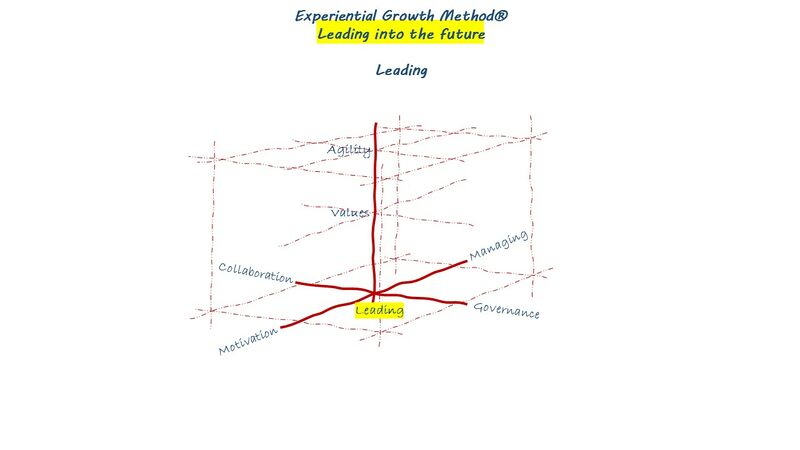Leading
Chapter 3 - Experiential Growth Method® - Deeper dive
Back to Action fields or Book content
.
Welcome to the Leading page
.
What is Leading?
Leading is the ability to combine three skills:
- 'negotiation / governance'
- 'coaching / motivation'
- 'managing'
with one goal: collaboration to realise the company's strategy.
.
Thinking about the concept
A visual thesaurus search is always an excellent starting point to discuss a concept definition:
| LEADERSHIP |
|---|
| https://www.freethesaurus.com/leadership |
.
.
Relations of Leading within Leading into the future (and Corporate- & organisational futuring)
.
.
There exists a close vertical relationship within Leading into the future:
- Outer focus: Agility
- Other focus: Value development
- Inner focus: Leading
.
On the Inner focus level, an affiliation exists with Organisational futuring:
- Motivation
- Collaboration
- Managing
- Governance
.
And Corporate futuring:
- Long term thinking
- Supporting
- Steering
- Appreciation
.
In concrete terms, this means:
- The trio - 'Leading', 'Value development' and 'Agility' - is inextricably linked.
- Your 'Leading' contributes substantially to 'Governance', 'Motivation', 'Collaboration' and 'Manging'.
- Furthermore, 'Leading' is part of the Inner focus level where 'Organisational-' and 'Corporate futuring' meet.
.
.
Questions we can ask ourselves when contemplating Leading
- Supports our 'Leading' our 'Value development' and our 'Agility'?
- Is our 'Leading' robust enough to generate a viable 'Motivation', 'Collaboration, 'Managing' and 'Governance'?
- Is our Leading a 'collider' or a 'mediator'?
.
Deep dive
.
Clearly Communicating your Company’s Strategy
Survey after survey reports that employees seem to be in the dark when it comes to their organisation's strategy, despite claims by senior management that their strategy is clear, clearly communicated and well-understood. I have always been fascinated by this apparent mystery and I have tried to understand why it exists and what we can do to make our strategy better-understood by employees. For effective execution of strategy, employees need to know and understand the choices that their organisation has made. Unfortunately, even clear communication of these choices is not enough because communication in the absence of context can lead to misunderstandings and lack of clarity. Since it is impossible for leaders to explain the full context in which they made their strategy choices, they have to find different ways to help their employees understand and appreciate their choices. Involving employees in the development of strategy, linking the choices made to the organization’s purpose, and communicating not only the choices made but the alternatives considered and rejected can be effective ways to bring employees on board quickly and make the strategy choices more memorable.
Present the rejected alternatives
Explaining why not can often help you explain why. In presenting a strategy, therefore, you can also present the alternatives considered and explain why they were not adopted. Communicating a strategy in this manner allows people to not only understand what choices were made but also what alternatives were considered for each choice. More importantly, it invites people to either ask for clarification as to why the alternatives were rejected or challenge the choices made by top management. It is the discussion that follows such challenges or clarification requests that eventually lead to a better understanding of strategy, not whether the original communication was clear.
Link to purpose
You should also link your strategic decisions to your company’s purpose or goal. Explaining to employees how each choice is linked to the organization’s purpose is a good way for people to quickly understand the logic behind the choice without needing to know all the deliberations that took place to make the choice.
Involve employees in strategy development
Employee participation and inclusion in the strategy process can take many forms, from simply soliciting ideas and feedback through to active participation in strategy workshops and testing of new strategic initiatives.
| Content source |
|---|
| 3 Ways to Clearly Communicate Your Company’s Strategy - Constantinos C. Markides & Andrew MacLennan - HBR - 2024 |
.
